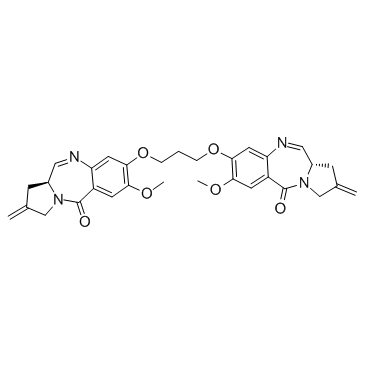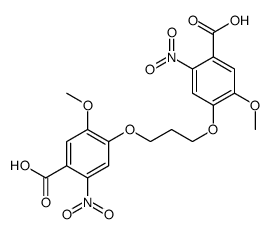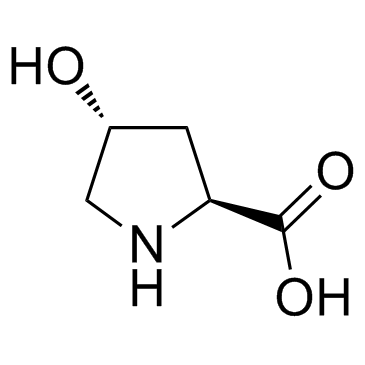| Description |
SJG-136 is a DNA cross-linking agent, with an XL50 of 45 nM for pBR322 DNA; SJG-136 has potent antitumor activity.
|
| Related Catalog |
|
| Target |
XL50: 45 nM (pBR322 DNA)[1]
|
| In Vitro |
SJG-136 (dimer 5) is a DNA cross-linking agent, with an XL50 (concentration of agent required for 50% cross-linking of pBR322 DNA) of 45 nM for pBR322 DNA. SJG-136 is cytotoxic to ovarian cell lines, such as A2780 (IC50, 22.5 pM), A2780cisR (IC50, 24 pM), CH1 (IC50, 0.12 nM), CH1cisR (IC50, 0.6 nM), and SKOV-3 (IC50, 9.1 nM)[1]. SJG-136 (SG2000) also reduces the viability of a panel of canine cancer cells, with GI50 values ranging from 0.33 - >100 nM after a 1 h exposure, and <0.03 - 17.33 nM following continuous exposure[2].
|
| In Vivo |
SJG-136 shows more potent antitumor effect against CMeC-1 tumour at 0.30 mg/kg than 0.15 mg/kg either as a single dose or administered once a week for three weeks via dosed intravenously in mice. SJG-136-induced H2AX phosphorylation shows good correspondence, but less sensitivity, than measurement of foci[2].
|
| Cell Assay |
In vitro cytotoxicity is evaluated using the human ovarian carcinoma cell lines SKOV-3, A2780, and CH1, together with the cisplatin-resistant counterparts of the A2780 and CH1 lines (A2780cisR and CH1cisR, respectively). Viable cells are seeded in growth medium (160 μL) into 96-well microtiter plates and allowed to attach overnight. SJG-136 is dissolved in DMSO (to give a 20 mM concentration in each case) immediately prior to adding to the cells in quadruplicate wells. Final drug concentrations in the wells ranged from 100 μM to 2.5 nM as follows: 100, 25, 10, 2.5, 1 μM, and 250, 100, 25, 10, 2.5 nM. This is achieved by diluting the drugs in growth medium and then adding 40 μL to the existing well volume of 160 μL to give the final concentrations stated above. After 4 days (96 h), the medium is removed and the remaining cells are fixed using 10% trichloroacetic acid on ice for 30 min. Wells are then washed 3−4 times with tap water and air-dried overnight, and 100 μL of 0.4% sulforhodamine B (dissolved in 1% glacial HOAc) is added to each well. Staining is allowed to continue for 10−15 min; the wells are then washed 3−4 times with 1% acetic acid and air-dried, and Tris base (100 μL of 10 mM) is added to each one. The plates are then shaken and absorbance readings taken at 540 nm using a plate reader. From plots of concentration versus percentage absorbance (compared to 8 untreated wells), IC50 values are calculated using the Quattro-Pro software package[1].
|
| Animal Admin |
A homogenous suspension of 5 × 106 exponentially growing canine melanoma cells in serum free RPMI 1640 tissue culture medium is injected subcutaneously into CD1 Nu/Nu immunocompromised female mice. The mice are divided into five groups of ten mice, with equivalent mean tumour volumes for each group. SJG-136 is given intravenously into the tail vein to four of these groups and vehicle control is administered to the fifth group. SJG-136 injections are prepared in 0.9 % NaCl and 1 % DMSO vehicle. Animals are weighed prior to the injection to determine the volume of SJG-136 required (0.1 mL/10 g body weight) which is given IV in the tail vein. Control group mice are given an IV injection of the vehicle solution; mice in groups one and two are given a single treatment of SJG-136, 0.15 mg/kg and 0.30 mg/kg respectively; mice in groups four and five are given 0.15 mg/kg and 0.30 mg/kg respectively, every seven days for a total of three treatments[2].
|
| References |
[1]. Gregson SJ, et al. Design, synthesis, and evaluation of a novel pyrrolobenzodiazepine DNA-interactive agent with highly efficient cross-linking ability and potent cytotoxicity. J Med Chem. 2001 Mar 1;44(5):737-48. [2]. Mellinas-Gomez M, et al. Activity of the DNA minor groove cross-linking agent SG2000 (SJG-136) against canine tumours. BMC Vet Res. 2015 Aug 19;11:215.
|

![1,1'-[[(propane-1,3-diyl)dioxy]bis[(11aS)-7-methoxy-2-methylidene-10-((2-(trimethylsilyl)ethoxy)methyl)-1,2,3,10,11,11a-hexahydro-5H-pyrrolo[2,1c]-[1,4]benzodiazepin-5,11-dione]] Structure](https://www.chemsrc.com/caspic/276/1221969-15-8.png) CAS#:1221969-15-8
CAS#:1221969-15-8![1,1'-[[(propane-1,3-diyl)dioxy]-bis(11S,11aS)-10-(allyloxycarbonyl)-11-hydroxy-7-methoxy-2-methylidene-1,2,3,10,11,11a-hexahydro-5H-pyrrolo[2,1-c][1,4]-benzodiazepin-5-one] Structure](https://www.chemsrc.com/caspic/409/232931-64-5.png) CAS#:232931-64-5
CAS#:232931-64-5 CAS#:140658-45-3
CAS#:140658-45-3 CAS#:51-35-4
CAS#:51-35-4 CAS#:126408-14-8
CAS#:126408-14-8 CAS#:232931-59-8
CAS#:232931-59-8